|
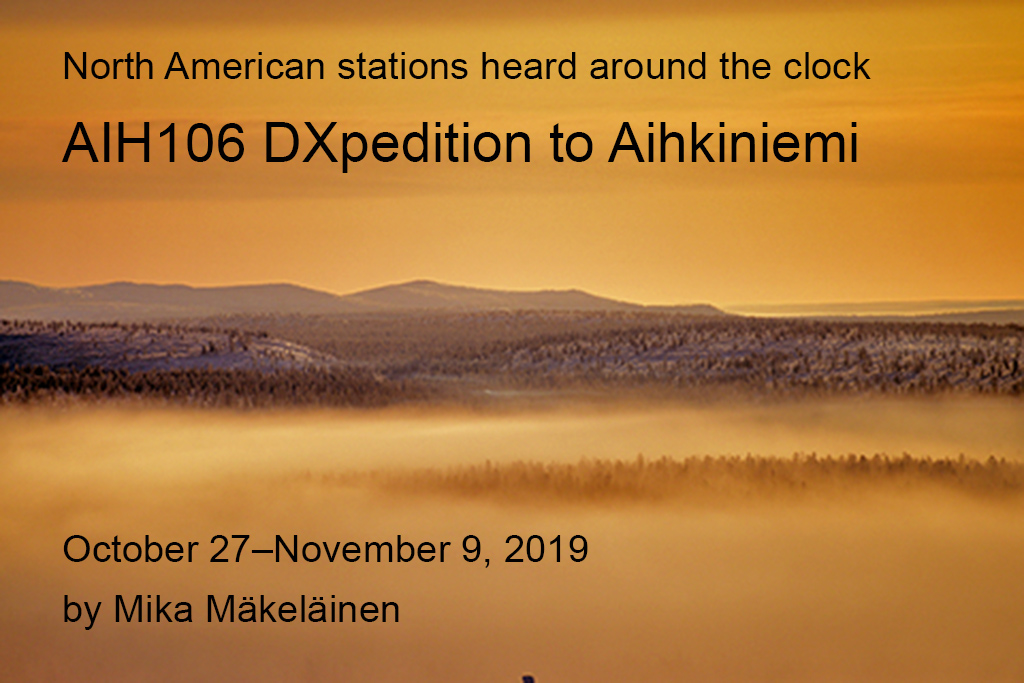
The ionosphere was
recovering from a storm, so DXpedition AIH106 got
off to a slow start. However, by our second week
North American signals filled the AM band from sunrise
to sunset, and occasionally also overnight. Other
goodies were caught from all around, including countries
like Argentina, Nigeria, Japan and even New Zealand.
Although sensational new discoveries were not made,
DXing felt just as rewarding as it should now that
we're living the solar minimum.
Barely
two weeks after returning from DXpedition AIH103,
I was ready to return to Aihkiniemi.
Well, almost ready. Getting on this DXpedition was
quite a hassle, and my Saturday schedule didn't
allow for any delays.

Winter arrived early this year. This scenery
is from Saariselkä ski resort. |
I
was arriving from Seoul, South Korea, where I held
a presentation about North Korea in a conference
about Inter-Korean
media cooperation, and my plane touched down
in Helsinki at 14:15. I knew I could only have hand
luggage, as I had to run through the airport, get
a taxi home, take a quick shower, pack my car, and
start driving towards the Pasila train station.
Again a bit of running in Pasila,
as I headed for the convention center, where I held
a book talk about Kimlandia
(my most recent book, featured also on Facebook)
at Finland's biggest book fair at 16:00. After signing
books I returned to the Pasila train station to
drive my Auris onboard the train at 18:00. Jim
Solatie joined me at this point, and now we
were finally able to relax. We did some last minute
purchases at the Mall of Tripla, a brand new shopping
center built on top of the railroad tracks, and
claiming to be the largest mall in the Nordic countries.
Because of the Korea and book
fair engagements, our departure was delayed by a
day, as normally we would travel north already on
a Friday evening.
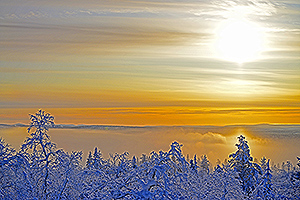
Can winter get any more beautiful than this?
(Click the photos to see a larger image.) |
The train departed as scheduled
just before 19:00. We had an extra hour of sleep
as this was the night when daylight savings time
ended, and the train stayed put for an hour in Oulu.
Even with this flexibility,
the train arrived in Rovaniemi an hour late because
of a technical problem at a railroad switch up in
the north, so already at start we were two hours
behind the regular schedule, when measured in UTC.
Fortunately offloading the cars went smoothly, so
after a breakfast at the Rovaniemi railway station
we set off driving north from the Arctic Circle
at 8:44 (0644 UTC).
We encountered plenty of reindeer
along the way. The road was snowy and icy, but on
a Sunday morning there was hardly any traffic. The
weather was exceptionally nice when we reached the
Saariselkä ski resort, so we made a small detour
to enjoy the views from on top of Kaunispää
fell, and I made a couple of rounds with my Mavic
Air drone to capture the snowy landscape. Photowise
this was the highlight of the trip.

Flying a drone over Kaunispää fell
in Saariselkä ski resort on the way up
to Aihkiniemi. Clicking the photo opens the
video on Youtube. |
After shopping in Ivalo and a
lunch at a Neste service station in Inari, we drove
further, arriving in Aihkiniemi at 16:30 local time
(1430 UTC), when it was already getting dark.
This time of the year the weather
can be dramatically different in the south and north
of the country. In Helsinki it was close to 10 degrees
C (50 F) and raining, while up in northern Lapland
it was well below freezing, and there was already
an unseasonally heavy snow cover, about 30 cm in
Aihkiniemi. During the following night the temperature
fell down to -22 degrees C (-8 F).

The top of Kaunispää fell as seen
from a drone. |
By the time our gear was
functioning, the afternoon opening to East Asia
was gone, and there were mostly European and Middle
Eastern stations left on the dial. Propagation conditions
were auroral, so we focused on African stations.
Jim heard BBC Mauritius on 1575 AM, and I picked
up Ultimate Radio from Lesotho on 891 AM. I've heard
snippets of its programming for more than a decade,
but any ID had eluded me, until now.
As
customary, I had Perseus type SDRs with Jaguar
software, and Jim was using Perseus receivers with
the manufacturer's software. Our antenna arsenal
remained the same as on previous DXpeditions, with
13 Beverage antennas, each 3,000 ft/1 km in length.
These are the antenna directions in Aihkiniemi:

Here's a daily summary of our observations on the
AM dial.
Monday,
October 28, 2019
Very few North American stations
were heard during the night. A few common ones from
the Rockies were audible at 0100 UTC, and then some
more, mostly from the Midwest, around 0500 UTC,
but at sunrise around 0600 UTC everything vanished.
The same applied for South America. We caught a
few personal new ones from Argentina around 0530
UTC, but they also disappeared from the dial at
sunrise.
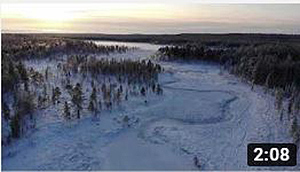
Flying a drone over Turvelompolat right next
to Aihkiniemi. Clicking the photo opens the
video on Youtube. |
During the day freezing temperatures
had eased a bit, warming up to -10 C, and we checked
a few antennas. Despite my doubts, it turned out
to be safe to walk on the ice of our small pond.
Not having to use a rickety bridge half a kilometer
away shortens the walking distance to most antennas.
The landscape was really wintry, and walking in
the snow-covered swamp was already harder than a
few weeks ago. Jim shoveled the driveway clear,
but in the evening we got some more snow.
In the afternoon, stations from
the east began to show up after 1300 UTC, and by
1400 UTC the focus was already in Southeast Asia.
We caught a few new catches, DYMF Cebu on 963 AM,
Radio Bangladesh Thakurgaon on 999 AM and Radio
Pakistan Quetta on 1134 AM. There was no sign of
Aussies, and the evening was once again dominated
by European and Middle Eastern stations.

A fell rising above clouds, shot from Kaunispää
in Saariselkä. |
Tuesday, October 29, 2019
Overnight, a few US and Brazilian
stations were heard peaking at 0230 UTC, but otherwise
transatlantic reception was poor. Stations from
Brazil and Argentina disappeared after 0300 UTC,
which was remarkably early. 0300-0430 UTC was quiet
to pretty much every direction, but South American
stations (such as Radio Nacional San Rafael on 620
AM and Radio Chilena on 1030 AM) recovered for a
moment after 0500 UTC. The lull before sunrise made
me venture into Africa, which paid off handsomely.
A few Nigerian stations (for instance Adamawa BC
on 1440 AM) were heard better than ever before as
they began their broadcast day after 0430 UTC.
Except for dips at 0700 and 0800
UTC, North American signals continued to be heard
with fairly good levels all through the day until
dying out after 1300 UTC. Nothing from the East
Coast was heard, but instead the focus remained
in the northwestern corner of the US. Identified
stations included 550 KARI, 610 KONA, 890 KVMX,
1150 KAGO and 1300 KROP — so far nothing personally
new. Stations from Oregon, Washington, Idaho and
Montana dominated the graveyard channels. Jim caught
KBZY Salem OR on 1490 AM, a personal new, but weirdly
I had no trace of the ID.

Enjoying dinner at Restaurant Aanaar, from left
to right Mika, Håkan, Hannu and Jim. |
During the day we once again
checked some antennas. The weather was sunny and
the daytime temperature -8 C. After arriving back
in the cabin, at around 1210–1300
UTC we heard three stations from New Zealand (1035,
1107 and 1161 AM), and Tonga (1017 AM) offered neat
reception even longer. At the same time, most Alaskan
stations had mighty signal levels, but we found
nothing personally new. Our luck was better with
Japan, which dominated the Asian scene until past
1400 UTC, and we netted a couple of new NHK1 stations.
Australian ABC was heard on 630 and 1548 AM. After
1500 UTC Asia sounded like a typical mishmash of
stations from China to Iran.
In the evening, we drove to Inari
to shop for groceries and then dine with fellow
DXers Hannu Tikkanen (HAT) and Håkan Sundman
(HS) at Restaurant Aanaar, part of the riverfront
Hotel Kultahovi. HAT and HS were DXing in Lemmenjoki
until Saturday. Driving on the quiet and dark country
roads we encountered lots of reindeer, a curious
fox, and a rescue truck trying to pull a minivan
— which in some strange manner had ended up
on the forest side of a road railing — back
on the road. Surprises after almost every turn!
Late in the evening, Brazilian
stations were pretty strong at 2100 UTC, and we
even heard the first US signals around the same
time, well before East Coast sunset.
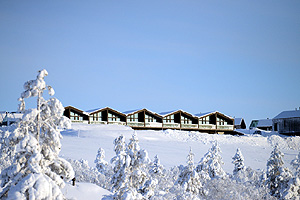
Luxury villas on top of Kaunispää.
A night in one of these would likely cost as
much as a week in Aihkiniemi. |
Wednesday, October 30, 2019
Overnight turned out to be good,
at least from around 0330 UTC, when North American
signals improved. Stations were heard from coast
to coast, and also Latin American stations from
north to south were present. Signal strength remained
decent for about three hours after sunrise at 0615
UTC. It was especially nice to hear many Colombian
and Cuban stations well into the daylight. We identified
stations like Radio Carrousel 660 AM, WPNW 1260
AM and WMLM 1520 AM.
North American stations gradually
weakened and the focus shifted, following a familiar
pattern, to the northwestern corner of the US. However,
they was no daytime break in listening, because
a new eastern front opened. The most common Pacific
islands nations of Tonga (1017 AM), the Marshall
Islands (1098 AM) and Kiribati (1440 AM) were heard
already around 1000 UTC, as were some Japanese stations,
allowing us to hunt for new NHK1 stations at the
local ID break of 1000 UTC. Kiribati was heard also
on 846 AM, giving Jim a new station and a new radio
country! A few Kiwis were heard as well, but nothing
new for us.
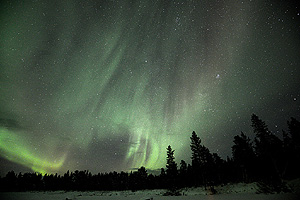
Aurora borealis occurred especially during the
first few nights, but most of the time it was
too cloudy to enjoy the light show. |
Everything from Asia arrived
much earlier than usually. ABC Emerald QLD on 1548
AM was heard already at 1050 UTC. An unknown station
with Bollywood music and announcements about hip
hop was noted by Jim on 1611 AM under the common
Philippine station DWNX. With investigative help
from Martti Karimies, this station turned out to
be Pop Desi from Tasmania, using one of the legacy
transmitters left unused by the now defunct Rete
Italia network. Late evening was uneventful —
scattered catches from East Asia, but nothing worth
mentioning.
Thursday, October 31, 2019
North American signals rose very
slowly from the background noise after 2100 UTC.
At 2300 UTC I even found one personally new station,
but after midnight UTC there was a deep retreat.
We slept through the rest of the night, but based
on Jaguar tracks on my PC screen, some common North
American stations have been audible around 0130
and 0300 UTC. Signal levels began to rise before
0500 UTC and the entire North American AM band was
available well into the afternoon. Latin American
stations were weak in the morning, with the exception
of Cuban and some Colombian stations. Even a fleeting
East Coast focus was very welcome, although most
identified stations (such as WSKW 1160 AM, WMMB
1240 AM and WFEA on 1370 AM) with hefty signals
were already familiar to us.
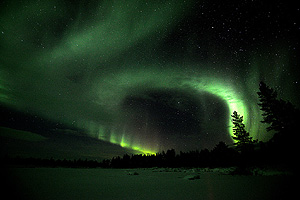
Northern lights shot from the small lake next
to our cabin. |
I went back to sleep after sunrise,
but woke up to check the eastern front before 0900
UTC to see if Cook Islands would happen to be audible
on 630 AM. No such luck, as KIAM from Alaska is
so strong here, but plenty of other stations from
the Eastern Hemisphere were already present. This
turned out to be one of the strongest openings to
the Pacific that we have ever experienced, and also
one of the earliest, because most stations were
heard already before 0900 UTC, including even a
bunch of Japanese stations from Hokkaido. Radio
Kiribati from Kiritimati closed down on 846 AM with
a good signal, and 2AP from Samoa was heard strong
on 540 AM. Fiji was heard both on 558 and 990 AM,
as well as the more common Tonga (1017 AM), Marshall
Islands (1098 AM) and the other Kiribati station
(1440 AM).
The weather remained bitterly
cold with a daytime high of about -13 and a nighttime
low of -23 C.
In the early afternoon, in broad
daylight, Midwestern stations were still going strong,
as were Alaskan and Hawaiian stations, so it was
difficult to choose which area to focus on. Despite
Alaska and Hawaii putting out stronger signals than
on any previous day this fall — as far as my
DXpeditions are concerned — it was soon clear
that none of our very few missing stations would
be available.

A freezing landscape surrounds the Aihkiniemi
cabin. This was shot straight down from a drone. |
New Zealand showed up more forcefully
than on previous days. Newstalk ZB popped up on
1035 AM already at 1000 UTC, and for the next three
hours we identified about 20 Kiwi stations. Even
though we already have 80+ stations verified, we
were lucky to score a couple of new ones; Rhema
on 540 AM and Radio Ake on 1179 AM, a Maori station.
Jim also heard the Chinese Radio from Auckland on
936 AM. If you are looking to get your first Kiwi,
your best shot would be either NewstalkZB on 1035
AM or Magic Talk on 1107 AM, which consistently
has even more oompf than 1035 AM, and which also
suffers from relatively little interference, at
least before all the Asian stations pour in. In
any case, you need a very directional antenna and
low background noise.
As the eastern wave began early,
it also died down early. It seems that by 1400 UTC
all of Asia and the Middle East was already heard
in a hodgepodge of stations from the east. Some
X-band Aussies had decent signals, but at least
so far we haven't found any rarities.
Friday, November 1, 2019
Late Thursday evening and early
Friday morning would be our last good chance to
capture daytime-only stations, and we were ready
to stay up late. It wasn't necessary though, as
propagation conditions were lousy. North American
stations surfaced too late, signal levels were poor
and European interference was heavy.

Landing closer to the cabin. |
Even at sunrise signal levels
remained pathetic. Signals from South America were
weak, although some common Colombian stations (such
as Radio Viva Cali on 1290 AM) were identified as
late as 0800 UTC. Earlier also Peruvian and Puerto
Rican stations were part of the mix.
During the daylight hours US
stations gradually gained strength, but among the
many identified stations (such as KBAR 1230, KLIX
1310, WKMI 1360, KYLT 1340, KFXN 1380, KBCK 1400
and KVTA 1590 AM) we didn't find any rarities.
Pacific stations emerged early,
with Tonga (1017 AM) leading the way already at
0850 UTC. Overall, signals were however much poorer
than on the previous day, and just a couple of Kiwis
were identified. By 1200 UTC most of Asia seemed
to be fighting for domination of the dial, and it
became next to impossible to score new ones. Jim
however identified one neat catch, Ningbo Lao Shao
Guangbo on 1251 AM. I slept most of the evening,
but Jim monitored the AM dial, which didn't offer
anything special later on. I didn't get a single
new station.
Saturday, November 2, 2019
In the evening North American
stations began appearing on the dial as soon as
the sun set, and signal levels were decent, but
we didn't spot any rarities. At the same time, Brazilian
stations were quite strong, and it seemed to turn
into a good night — but we need to sleep at
some point. When we woke up before 6 AM, South American
stations were gone, but North American stations
were in full swing.
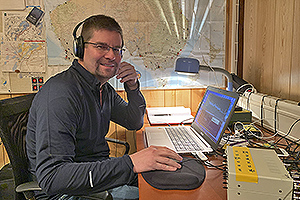
Jim Solatie with a map of Aussie catches made
in Aihkiniemi behind him. |
There was no drop whatsoever
around sunrise, and this turned out to be the best
day of the week for hunting North American stations.
The propagation pattern was quite common: Canadian
stations tended to be on top where ever they exist,
and from the US, the upper Midwest had an upper
hand. Stations were heard from sea to shining sea,
but luckily the northwestern corner of the US was
not quite as dominant as it normally tends to be
during daylight hours. Anyhow, the sheer number
of stations, and the resilience of the opening,
lasting to around 1400 UTC, was impressive. I especially
enjoyed hearing a few Texan stations.
Initially we found only a couple
of new stations, but there are bound to be more.
To give an idea of what was available, for instance
these semi interesting stations were logged: 550
WGR & KTRS, 590 WKZO, 610 KCSP, 620 WVMT, 690
XEW, 830 XEITE, 870 WHCU & KPRM, 940 KVSH, 1030
KBUF, 1040 XESAG, 1080 WNWI, 1140 KGEM, 1260 KWYR,
1320 KELO, 1420 WVJS, 1530 KGBT, 1550 WJIL &
KCIS and 1580 KNIM. Graveyard channels opened only
in the afternoon and seemed to be offering just
the usual suspects.

Mika Mäkeläinen with a map of Micronesia
and a poster from Colombia in the background. |
Even before 0900 UTC we started
making sporadic checks on the eastern front, but
as it didn't feel exceptionally good, we focused
entirely on North American stations for as long
as they lasted. Later in the afternoon we visited
one of our neighbors, and neglected close monitoring
of Asian stations. Based on what we've checked,
there was however nothing of interest.
In the evening, WLQV on 1500
AM was heard already at 2045 UTC, raising expectations
for the rest of the night.
Sunday, November 3, 2019
Sunday seemed like a repeat of
Saturday. Initially, on late Saturday evening signals
from Brazil were strong, but well before sunrise
stations from the southern half of South America
lost the battle to North American stations. Several
US stations appeared well before local sunset, such
as WLQV 1500 (identified at 2045 UTC) and WLIB 1190
(at 2119 UTC), which could have offered an opportunity
to catch daytime-only stations, but we didn't spot
any.
We slept through most of the
night, but it seems that nighttime reception was
poorer than on the previous night. I found two common
graveyard stations, WGIL (1400 AM) and WOSH (1490
AM) at 0300 UTC, when reception was best.
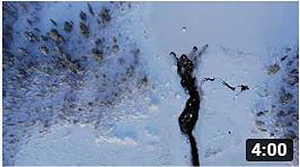
Taking off from the Aihkiniemi cabin, flying
around and landing. Clicking the photo opens
this drone video on Youtube. |
Reception improved in the morning
and was very similar to Saturday, except that signals
began to weaken considerably after 1000 UTC. Once
again stations were logged coast to coast, north
to south, and especially in the morning hours, also
in the very low end of the dial (including WFLF
& XEWA on 540 AM). Here are some other examples
of identified stations that are not heard daily:
550 WGR, 610 CKTB, 620 WVMT, 660 XEEY, 680 WRKO,
710 KCMO, 790 WTNY, 1070 WTSO, 1160 WCVX, 1230 WMMB
& KWIX, 1240 KFOR, 1450 KYNT, 1520 WMLM and
1590 KCTY.
By 1100 UTC Tonga and Marshall
Islands were booming, but there was no sign of Kiwis
nor Japan — just one East Asian station was
heard, Taiwan on 1557 AM — so we continued
hunting for new stations from the west. The last
US stations vanished after 1400 UTC, but even after
that reception from Asia was lackluster. A few bursts
of stations from Japan and India were noted as darkness
fell, but it was nothing to get excited about.
Freezing weather continued with
temperatures down to -20 C (-4 F) in the evening.
It had been snowing a bit, so we needed to shovel
the yard and driveway.
Monday, November 4, 2019
Late Sunday evening was very
similar to the previous two nights, except that
signals surfaced even earlier. Here are some examples
of stations noted well before local sunset: 1030
WBZ at 2019 UTC, 1120 KMOX at 2130, 1200 CFGO at
2019 UTC, 1200 WMUZ at 2127, 1320 WILS at 2130 UTC,
and 1580 CKDO at 2017 UTC. However, we noticed only
few stations with daytime power, and none of them
were new to us. For example, WNWC on 1190 AM put
out a mighty signal on 1190 AM at 2200 UTC.
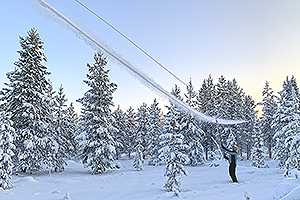
Jim dropping snow from the 80-degree antenna
wire. |
Overnight there was more variation
in signal levels than on previous days. Latin American
signals were poor, but North American stations were
audible with better than average quality aside from
sinking at 2300 and 0300 UTC. After sunrise (today
at 0643 UTC), signal levels dropped once again,
but recovered pretty well, especially on the upper
half of the AM band. Geographically, Canadian stations
dominated again, and most regional channels were
covered by very familiar stations from around the
Great Lakes, but there were isolated signals from
coast to coast, and from Mexico to Alaska.
The selection of stations was
less interesting than during the weekend, and Jim
opted to use the sunny day to drive up to Kirkenes
for a short Norway excursion. Unfortunately the
North American opening also ended earlier than before,
and midwestern stations were gone after 1200 UTC,
when daytimers could have been heard. I didn't get
a single new station, unless recordings contain
hidden gems.
Tonga and the Marshall Islands,
along with some Japanese stations, appeared at 1020
UTC, but there was nothing interesting on the eastern
front. By 1130 UTC there was a mixed bag of Asians
on the dial without a particular focus. For the
first time UK stations were so strong through the
day that they covered some potential Kiwi frequencies,
eg. 1107 AM.
In the afternoon, the opening
to Asia was miserable. A little bit of something
from everywhere — impossible to get anything
new. But the evening was saved by a promise from
the west: CBC was heard on 1230 and 1400 AM already
at 1820 UTC, earlier than I have heard them before.
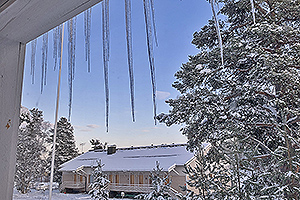
Jounila is a nearby motel where we normally
drive daily to take a shower. |
Tuesday, November 5, 2019
Monday evening was an unforgettable
experience in how early North American signals can
appear, often up to 1.5 hours before local sunset.
Here are some examples of when these Great Lakes
and Midwest stations were logged: 1040 WHO at 2200,
1120 KMOX at 2200, 1190 WNWC at 2130, 1280 WHTK
at 2110, 1390 WFBL at 2113 and 1590 WGBW at 2134.
Monitoring stations fading in and out was thrilling,
and expectations for daytimers were sky-high, but
eventually we both managed to nail just one personally
new daytimer. There might of course be more when
we some day (early retirement?) have enough time
to carefully listen to these recordings.
At 2240 UTC the signals suddenly
collapsed, and so did we. Automated recordings took
care of the rest of the night. A quick Jaguar review
revealed that moderate reception continued through
the night, except for another black hole after 0200
UTC. Signal levels continued fairly steady until
after 1100 UTC, when the eastern half of North America
began to fade out rapidly.
The Great Lakes area ruled most
of the time, but we did get some more East Coast
stations, which is always a treat, and offers a
better opportunity for new catches. Here are some
examples of the stations heard until early afternoon:
560 WQAM, 790 WPRV, 810 Caracol, 830 WCRN, 930 KSEI,
1110 WJML, 1140 WRVA, 1330 WYRD, 1350 WOYK, 1360
KRKK, 1370 WFEA. A bit later in the day, when only
the West Coast stations remained on the dial, we
logged for instance 860 KTRB, 1220 KHTS, 1280 KLDY
and 1300 KROP — so this station is now active,
although listed as inactive in the latest AM Radio
Log. Graveyard channels remained mushy most of the
day, and individual stations were mostly heard only
in the afternoon.
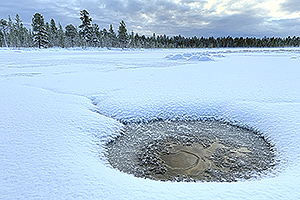
A spring remains open long after temperatures
fall below freezing. |
Around sunrise there were also
some Cuban and Colombian stations, but nothing worth
mentioning.
It had snowed some more, so shoveling
snow and dropping snow from antennas wires were
the excercise choices of the day.
Since North American stations
offered more promise, we didn't pay much attention
to the eastern front. There were hardly any stations
from the Pacific. The first wave of random Asian
stations arrived before 1100 UTC, after which signals
dipped, and improved again by 1200 UTC. Already
after 1300 UTC the AM band was crowded with stations
from South Asia, and a bit later by stations from
the Middle East, so the opening to East Asia was
unusually short. It didn't seem to improve, so I
just went to sleep early.
Wednesday, November 6, 2019
Late Tuesday evening was disappointing;
nothing from East Asia, and overseas signals were
much weaker. Actually, Brazilian stations were heard
even with our North America antennas. Some of the
common northeast stations from Brazil, such as Rádio
Difusora Vale do Curu from Pentecoste, Ceará,
on its distinctive split frequency of 1559.813 kHz
were logged. Even at 2200 UTC, from North America
only a few New York City powerhouses were fleetingly
audible.
During the night we let automated
recordings to do the job, but it appears that aside
from the southern half of South America, there have
been just some isolated stations here and there
from around the Americas. A bit more North American
stations began to appear after 0500 UTC, while signals
from Brazil started to tank.
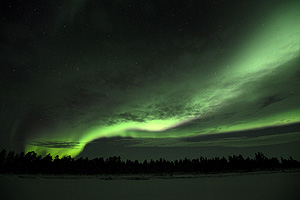
Northern lights forming a string across the
sky. |
Because transatlantic reception
was poor, I even had time to check frequencies on
this side of the pond. A new religious broadcaster
was indeed operating on 1476 AM (as discussed at
the time on RealDX mailing list) from Benin. It's
supposed to be TWR, but I heard an ID for Radio
ELWA at 0400 UTC, and I suspect that it has been
caught in the broadband nets also many times before.
Carillon Wellbeing Radio from the UK dominated the
frequency an hour later at 0500 UTC.
Soon after sunrise we set out
to take care of the last remaining antenna chore:
reeling in the last 300 meters of the 100-degree
wire. We needed to remove it because of upcoming
logging in the area. Again it was freezingly cold,
-18 C, much colder than normally in early November.
We also checked the remaining two antennas and cleaned
snow from the wires.
North American stations continued
to be heard through the day, but only with average
strength and without any exciting catches. Here
are examples of identified stations: 570 WMCA, 580
CKWW, 640 WMFN, 690 XEN, 730 KDBI, 1080 WNWI, 1230
KBAR, 1280 KVXR, 1340 WNCO and 1580 KNIM.
Stations from the east began
rising before 1100 UTC from a broad area including
Japan, Koreas and China. Nothing special was heard
from the Pacific nor East Asia, but I made some
recordings for further review.
Thursday, November 7, 2019
Late Wednesday both Brazilian
and North American stations emerged later than on
previous days. WBBR on 1130 AM was one of the first
stations identified at 2130 UTC. Generally East
Coast & Great Lakes signals didn't seem to advance
in daylight like on previous days.
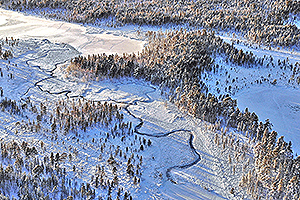
A narrow meandering river still remains unfrozen.
Lake Mutajärvi in the upper left corner. |
Overnight was a disappointment.
Both night and day, European stations, and especially
UK stations, were very strong. There were isolated
North American stations, especially around 0200
UTC, but most transatlantic reception involved stations
in Brazil and Argentina.
After daybreak North American
signals again took over, but the focus was much
more western, with a lot of stations from the Rockies,
for instance 550 KFYR, 590 KSUB, 610 KVNU and 630
KFXB. Later during the day the Great Lakes area
once again produced mighty signals, which collapsed
after 1000 UTC. As has been common for the past
week, a bunch of West Coast stations were heard
until past 1400 UTC.
During the day I had an accident
unrelated to DXing. A neighbor here asked me to
take aerial photos of his home with my drone. So
I did. All went well until a technical malfunction
brought the drone down in very difficult terrain.
We spent a couple of hours searching for the drone,
but were not able to recover it. Only later I discovered
that the last known coordinates were stored in the
DJI software, so I hoped to find it on a second
attempt Friday.
Jim spent time also cleaning
the antenna wires, which had accumulated loads of
snow, sometimes pulling the wires all the way to
the ground. This kind of antenna maintenance is
something that every crew in Aihkiniemi is obliged
to do in the winter.
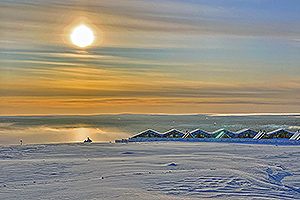
Villas on top of Kaunispää on our
first day in Lapland. |
Another set of problems was waiting
inside the cabin. Two laptops decided to call it
quits. So the afternoon and early evening were spent
trying to solve problems, and I have no idea what
the propagation conditions to Asia were like. We
made some recordings, and should be able to review
them within the next 20 years. We were also planning
to visit fellow DXers in Lemmenjoki, but canceled
it because we were overwhelmed with other issues.
And, did I mention that our two
splitters, which were professionally repaired last
summer, didn't work at all. Looks like we paid over
100 euros for nothing. Fortunately they weren't
our only splitters. An utterly shitty day.
Friday, November 8, 2019
The beginning of the night was
very modest. Brazilian stations were weak, and North
American stations even weaker, mostly just Newfoundland
stations with readable signals. On the opposite
side, unusually many Chinese stations were heard
during sunrise in Eastern China.

Clouds hanging low above Saariselkä. |
Later in the night signals from
the southern half of South America improved and
reached an impressive level in the morning around
0600 UTC, especially in the lower end of the dial.
Just before 0700 UTC North American stations grew
stronger, and Latin Americans weakened, so it was
easy to change the target area. Already at 0700
UTC the emphasis was heavily in the northern part
of the Rockies (Montana, Idaho, Wyoming & Alberta).
Later in the day the Great Lakes Region stations
persisted as well, but especially local channels
were so crowded that identifying individual stations
was very difficult. Here are examples of identified
stations: 540 XEWA, 570 KNRS, 730 KDBI, 750 KERR,
860 KTRB, 870 KLSQ, 880 KWIP, 1210 KHAT and 1240
KCID.
Asian stations started rising
after 1000 UTC, but again prospects for getting
new stations remained better on the vast western
front. Live monitoring suffered, because we had
to look for the drone. But good news — eventually
we found it! It was no further than ten meters from
the point where the last GPS reading placed it,
but it had made a relatively small hole in the snow,
and it was extremely difficult to spot. I had previously
walked a mere two meters away without noticing it.
The drone was broken beyond repair,
but I was still very relieved to recover it. I have
an insurance policy that will subsidize most of
the replacement drone as long as I can provide the
remains of the broken one. After the drone hunt,
we still had antennas to take care. Since we had
so much fresh snow, we checked and cleaned most
antennas twice during our two-week DXpedition.
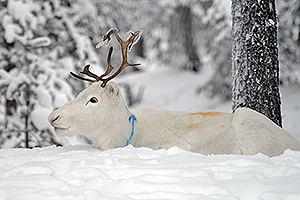
Reindeer close to Aihkiniemi. |
After checking the antennas,
Jim grew curious about the springs that remain unfrozen
in our lake through the winter. He got a bit too
close though, and fell through the ice. Luckily
it was close to the shore and the water was only
thigh high. Wet and muddy clothes — but a dry
cell phone.
After we returned from antenna
maintenance at around 1220 UTC, North American signals
were mostly gone, but the band was full of Asian
stations. X-band Australian stations were stronger
than on any previous day on this DXpedition, and
Jim managed to find one new catch.
As for the rest of the evening
and early Saturday, we mostly just used automated
recordings to get what was available.
Saturday, November 9, 2019
On the
last night I only tried to get enough sleep, since
it was a long drive on Saturday to Rovaniemi. Most
of Saturday morning was spent cleaning and packing.
After sunrise, reception conditions to North America
were roughly the same as on previous days. For instance
WTLN 990 and WTAB 1370 were logged. We unhooked
the last receivers at the very last moment, around
1110 UTC, and were ready to head south half an hour
later.

Reindeer staying stubbornly in the middle of
the road are the biggest driving hazard in Lapland. |
The next Aihkiniemi crew arrived
around midday. Timo Klimoff and Patrik Willför
would have an equally productive week DXing North
American stations. Finally, the solar minimum is
beginning to feel like a solar miminum should.
When we arrived in Rovaniemi some six hours later,
we grabbed a burger and headed to the railway station.
Sleeping on the train and waking up in Helsinki
was a relaxing way to end this fabulous two-week
adventure. For me, this was the end of the live
DXing season, but Jim would be returning to Aihkiniemi
later in the winter.
Reviewing our recordings is progressing
slower than ever before, because work obligations
took us on long business trips soon after returning
from Lapland. I traveled to Brazil and Jim to China.
Only now, five weeks after returning from the DXpedition,
I finally found time to edit ja publish this report,
which I hope will inspire you to plan DXpeditions
of your own. You could even be DXing in Aihkiniemi,
as the cabin is frequently rented by DXers, and
we have vacant slots every winter.
Text
and photos: Mika
Mäkeläinen
Published
on December 15, 2019
  
|